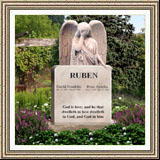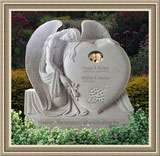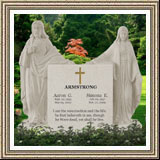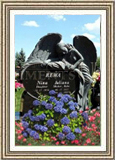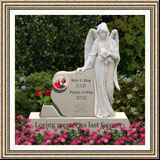|
Swastikas on Scottish Gravestones
By Stephen G Taylor
To date there does not appear to have been any paper of
substance or significance published on this topic in
English. Very little is known about these examples of
the Swastika in Scotland because they often appear in
unexpected places, off the beaten track and the relevant
artifacts are sometimes only found in museums.
In this article on the Swastika in Scotland we will be
looking at some of the earliest examples that have been
found. The story begins with that collection of Celtic
warrior tribes who came to be known collectively as the
Picts. They were well known for their artwork and many
examples of elaborately carved stones can still be seen
around the countryside.
Sometimes we come across simple Swastikas, and sometimes
complex designs with the general appearance of
Swastikas, as found on a grave slab now placed in the
Meigle Museum, Perth. Four figures have been arranged in
a Swastika-type pattern. The style is very similar to
the Kells Market Cross, in the Republic of Ireland.
While some of these examples clearly come from the
earlier pagan period many have a clear and unequivocal
Christian connotation. So where did this symbolic device
come from?
While most people speak of it as a 'Swastika', other
terms may be used. 'Gammadion' is particularly
appropriate when the symbol originated from a classical
Christian source, as found in the catacombs of Rome and
elsewhere in the early centuries of the Common Era. Its
name derives from the quadruplicated capital Greek
'Gamma'. On the other hand, 'Fylfot-Cross' may be used
when it can clearly be shown to have originated within
the British Isles, in parts of Western Europe, or when
the feet of this geometric device are shorter than the
cross-arms.
The Barhobble cross slab
Was there in fact a settled tradition of employing the
Gammadion on grave-slabs, as a Christian symbol, in the
period in which the Barhobble cross slab originated?
Discovered by Mrs. Sheila Cormack at Barhobble, Mochrum,
Wigtownshire, during the excavations of 1984-94, this
cross slab measures approximately 2ft by 1ft. and is in
shallow relief with an expanded arm cross, the surface
of which is plain except for an incised Gammadion on the
lower arm. Dating from the 10th or 11th Century, it was
closely associated with a local centre of Christian
worship.
It has often been thought that the Swastika had sprung
from pagan sources and was later 'Christianised'.
However, we may draw attention to those influences upon
Celtic iconography and symbolic tradition from the
South. Both St. Ninian (AD 360-432) and St. Patrick (AD
389-461) had warm contacts with the Continent and by
association the strong symbolic traditions arising from
those early years of Christianity in Rome.
It has been suggested that the Vikings in their
exploratory forays into Russia and beyond introduced the
Gammadion as a sacred symbol from Byzantium, but they
were already familiar with this device, whether regarded
as a symbol of Odin or Thor. It would seem then that
neither paganism nor Christianity could lay sole claim
to a symbolic device which had had such a long and
complex history.
Returning to Barhobble, can we answer the question as to
whether there was a settled and unequivocal Christian
tradition of using the Gammadion on grave slabs? The
evidence from neighbouring districts of Scotland and
Northern England appears to confirm this. Indeed there
are a number of examples of parallel usage in Scotland,
the Isle of Man and neighbouring Cumbria.
We discover a complex inter-play of Celtic and Viking
traditions of sepulchral art. As in Anatolia so in
Scotland Christian sculptors were happy to use
traditional pagan images but imbue them with new
meaning. Cross slabs from Ireland have often supported
the equal-armed Greek cross in close juxtaposition with
the Gammadion. In all likelihood they were regarded by
the sculptors of the day as freely interchangeable
representations of the Christian Cross. As we move
across to SE Scotland we find similar examples at
Cambusnethan, Wishaw and at the Greens, Carnwath.
Although the matter cannot be fully proven, there is, we
maintain, significant evidence to suggest that many, if
not all, of the appearances of the Gammadion in Scotland
were regarded by their sculptors as legitimate variants
of the Latin or Greek cross. In another article on the
Swastika in Scotland we take a look at the War Memorials
in Deeside and Edinburgh and the tradition that they
represent. |

